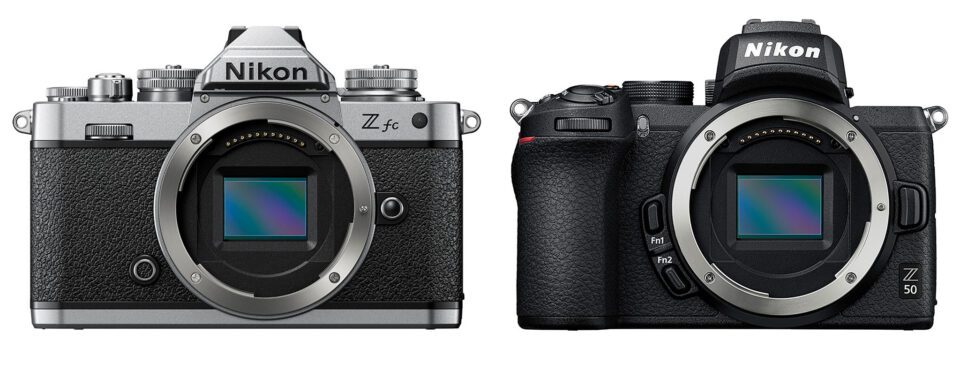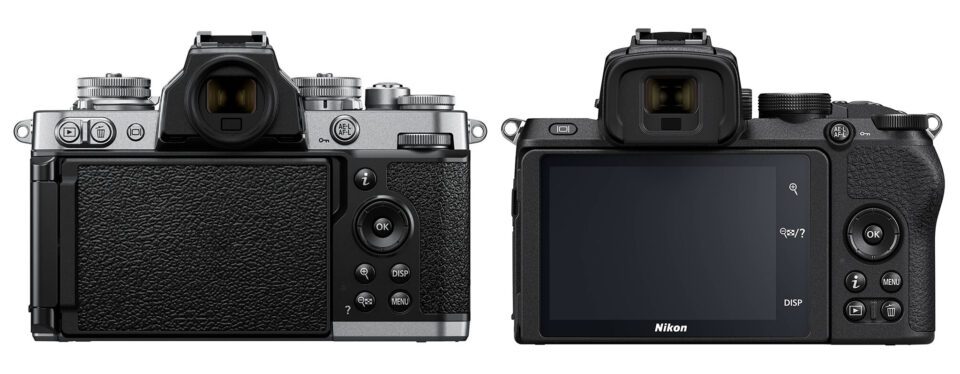Now that Nikon has announced the retro-themed Zfc mirrorless camera, a number of photographers may be wondering how it compares to Nikon’s other DX mirrorless camera, the Z50. The two have very different designs but many similar specifications. This article covers what you need to know.
Let’s start by taking a look at both cameras side by side. Here’s the front view, to scale:

Top view, to scale:

And rear view, to scale:

As you can see, the designs are very different overall. The Zfc has many more dials along the top of the camera, while the Z50 has Nikon’s usual Z-series control layout (though a less advanced version than on some Z cameras, with no AF-On button or joystick). The Nikon Zfc doesn’t have a built-in grip, which may make it uncomfortable for using heavy lenses for long periods of time, but Nikon has said that an optional grip attachment will be available when the camera ships at the end of July.
Despite the surface differences, the two cameras have nearly the same specifications. Here’s how they compare:
Nikon Zfc and Z50 Specifications
| Camera Feature | Nikon Zfc | Nikon Z50 |
|---|---|---|
| Announced | June 29, 2021 | October 10, 2019 |
| Sensor Resolution | 20.9 megapixels | 20.9 megapixels |
| Low-Pass Filter | No | No |
| Sensor Type | CMOS | CMOS |
| In-Body Image Stabilization | No | No |
| Sensor Size | 15.7 × 23.5 mm | 15.7 × 23.5 mm |
| Image Size | 5568 × 3712 | 5568 × 3712 |
| Pixel Size | 4.22 µ | 4.22 µ |
| Native ISO Sensitivity | 100-51,200 (204,800 extended) | 100-51,200 (204,800 extended) |
| Image Processor | EXPEED 6 | EXPEED 6 |
| Viewfinder | Electronic / EVF | Electronic / EVF |
| Viewfinder Resolution | 2.36 million dots | 2.36 million dots |
| Viewfinder Coverage | 100% | 100% |
| Viewfinder Magnification | 1.02× (0.68× FX equiv.) | 1.02× (0.68× FX equiv.) |
| Built-in Flash | No | Yes |
| Flash Sync Speed | 1/200 | 1/200 |
| Storage Media | 1× SD, up to UHS-I compatible | 1× SD, up to UHS-I compatible |
| Max Continuous Shooting Speed | 11 FPS (12-bit raw), 9 FPS (14-bit raw) | 11 FPS (12-bit raw), 9 FPS (14-bit raw) |
| Shutter Speed Range | 1/4000 to 900 seconds; time and bulb modes | 1/4000 to 30 seconds; time and bulb modes |
| Electronic Front-Curtain Shutter | Yes | Yes |
| Exposure Metering Sensor | TTL metering using camera image sensor | TTL metering using camera image sensor |
| Autofocus System | Hybrid PDAF | Hybrid PDAF |
| Focus Points | 209 | 209 |
| Eye AF | Yes; includes animal eye AF | Yes; includes animal eye AF |
| Eye AF in Wide Area AF Mode | Yes | No |
| Autofocus Detection Range (Standardized to f/2 Lens, ISO 100) | -4.2 to +19.3 EV (-2.7 to +19.3 EV without Low-Light AF) | -4 to +19 EV (-2 to +19 EV without low-light AF) |
| Video Maximum Resolution | 4K UHD @ 30p | 4K UHD @ 30p |
| 4K Video Crop Factor | 1.0× | 1.0× |
| HDMI Out / LOG | Yes / No | Yes / No |
| HLG / HDR Out | No | No |
| Eye AF in Video | Yes | No |
| Articulating LCD | Yes, fully articulating | Yes, tilt only |
| Touchscreen | Yes | Yes |
| LCD Size | 3.0″ diagonal | 3.2″ diagonal |
| LCD Resolution | 1.04 million dots | 1.04 million dots |
| Continuous External Power | Yes | No |
| Built-in GPS | No | No |
| Wi-Fi / Bluetooth | Yes / Yes | Yes / Yes |
| Battery | EN-EL25 | EN-EL25 |
| Battery Life (CIPA) | 300 shots | 300 shots |
| Video Battery Life | 75 minutes | 75 minutes |
| Control Layout | Retro; two command dials; dedicated shutter speed, ISO, and exposure compensation dials; hand grip available separately | Low- to mid-range; two command dials; built-in hand grip |
| Weight with Battery and Card | 445 grams (0.98 lbs) | 450 grams (0.99 lbs) |
| Dimensions (L×H×D); Depth Excludes Protruding Viewfinder | 135 × 94 × 44 mm (5.3 × 3.7 × 1.7 in.) | 127 × 94 × 60 mm (5.0 × 3.7 × 2.4 in.) |
| MSRP As Introduced | $960 body only; $1100 with 16-50mm lens | $860 body only; $1000 with 16-50mm lens |
| Lowest Price Seen | $960 body only (see current sales) | $900 with 16-50mm lens (see current sales) |
The Nikon Zfc and Z50 are very similar cameras. Most of the specifications above are exactly the same, with the two biggest differences being the Zfc’s retro theming and fully articulating rear LCD. The only meaningful advantage to the Z50 (other than price) is the inclusion of a pop-up flash.
Other advantages in favor of the Zfc include extended shutter speeds in manual mode (up to 900 seconds), slightly better low-light AF detection, and eye AF in wide-area and video modes. None of these features are going to be critical for most photographers, but they might help justify spending the extra $100 on the Zfc rather than the Z50.

Which One Should You Get?
Even though some specifications differences exist here and there, the biggest and most obvious reason to get the Zfc over the Z50 is if you want the retro styling and the dedicated shutter speed, ISO, and exposure compensation dials. On the flip side, the biggest reason to get the Z50 over the Zfc is price.
While both cameras are currently selling at similar prices new ($960 for the Zfc and $860 for the Z50), the Z50 has been out for much longer than the Zfc. If you’re willing to buy used or refurbished, you can save hundreds of dollars on the Z50, while the Zfc is so new that it won’t have similar exposure on the used market for a while.
If you’re going to buy either one new, I suggest the Zfc over the Z50. It’s not much more expensive but adds useful handling features (the dedicated dials) as well as a few other advantages here and there, like the fully articulating rear LCD. However, you’re certainly not giving up much if you opt for the slightly cheaper Z50, so there’s no need to agonize over the decision either way. Find a good price on either and move on. (Or consider the full-frame Nikon Z5 instead in the first place.)